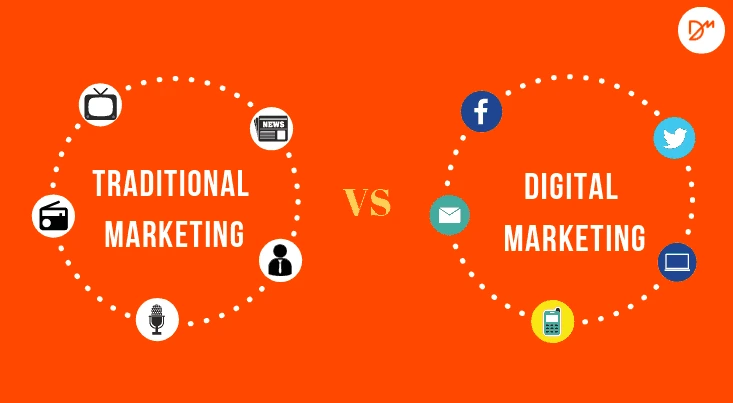So today’s businesses are same as they were in earlier times, today there are only 2 ways of doing marketing, one is Traditional Marketing which is going on since centuries, whoever knows the world of marketing understands it, and the other is Digital Marketing, this is new for some people but slowly it is proving to be very effective and people are understanding it as well. So in this article we will understand Traditional Marketing VS Digital Marketing, in this we will see which thing is good to buy and not.

Marketing Approaches
Whatever strategies the business wants, they should be very useful so that their business benefits a lot and they achieve their target, and mostly there are only 2 approaches
- Traditional Marketing: In traditional marketing, outdoor marketing is mostly based on word of mouth and TV, radio, posters, banners etc.
- Digital Marketing: the modern strategy that depends on websites, email marketing, social media platforms, Search Engine Optimization, Meta Ads, Google Ads etc
The methods of both are very different but the aim of both is same, to connect the customer with the business and whoever understands marketing well, plays very well in the market.
Key Features and Characteristics
Traditional Marketing
Traditional marketing mostly relies on the same methods that have been used before and are understood by the customers, and you understand those features:
- Tangibility: Print advertisements, flyers, and brochures create a physical connection with the audience.
- Mass Outreach: TV and radio campaigns can reach a vast audience at once.
- Local Impact: Ideal for targeting specific geographical regions.
- Static Messaging: Once created, the message remains unchanged throughout the campaign.
Digital Marketing
Digital marketing uses the internet and technology to connect with customers. Some its features are:
- Interactivity: Two-way communication through social media comments, emails, and chats.
- Targeted Campaigns: Advanced tools like Google Ads allow precise audience segmentation.
- Data-Driven: Access to real-time analytics for better campaign optimization.
- Scalability: Campaigns can grow and evolve based on user engagement.
Benefits and Limitations of Each Approach
Traditional Marketing
Pros:
- Because of its visual and visual stability, it is effective for brand recall.
- Better for audiences less familiar with digital platforms.
- Works well in regions with limited internet access.
Cons:
- Higher costs due to production and distribution.
- Limited tracking capabilities to measure campaign success.
- Reduced flexibility as campaigns cannot be altered once launched.
Digital Marketing
Pros:
- Cost-effective, especially for startups and small businesses.
- Allows global reach with minimal investment.
- Flexibility to modify campaigns in real-time.
- Detailed metrics help track ROI and campaign performance.
Cons:
- Requires a strong understanding of technology and tools.
- Risk of information overload for the audience.
- Dependence on internet connectivity and digital literacy.
Real-World Applications
Traditional Marketing Examples
- A local bakery using newspaper ads and distributing flyers to attract customers.
- National brands running television commercials during primetime.
- A retail store using billboards to promote seasonal sales.
Digital Marketing Examples
- An e-commerce platform using Facebook and Instagram ads to target young shoppers.
- A fitness brand leveraging YouTube tutorials and influencer collaborations to build a community.
- Email campaigns offer discounts to loyal customers.
Find the Best Strategy for Your Business?
The decision between digital and traditional marketing is determined by a number of factors, such as your target market, financial limitations, and corporate objectives. Here are a few situations to think about.:
- Use Traditional Marketing if:
- Your target market is less knowledgeable about technology and older people.
- You intend to focus on an area in particular or create a local presence.
- You have a significant budget to invest in large-scale campaigns.
- Use Digital Marketing if:
- Your audience is active online and engages with digital content.
- You need cost-effective solutions with measurable results.
- Establishing a global market or specialized market presence is your aim.
People should choose strategies according to their business and what kind of audience they have. Which method will give more profit to the business, that method should be used. After discussing all the strategies, you will understand it.
Topics that are related to each other:
- “Learn how Social Media Marketing thrives on user-generated content.”
- “Discover how Trends in Marketing emphasize the growing importance of UGC.”
- “See the impact of Display Advertising in Digital Marketing enhanced by user-generated visuals.”
- “UGC is a fundamental part of Content Marketing strategies today.”
- “Explore how Artificial Intelligence in Marketing leverages UGC for personalization.”
- “Understand the connection between Brand Marketing and authentic user-generated content.”
- “Start with the Fundamentals of Marketing to see why UGC matters.”
- “Explore the Principles of Marketing and their connection to UGC.”
Conclusion
So who wins in Traditional Marketing VS Digital Marketing, you will know which method is best for your business, if your business suits traditional then it is best for you but if you use digital marketing then it will not work as much as traditional marketing, then you will have to understand your business and audience.
After understanding which method is good and implementing it properly, your business will grow very well. Traditional Marketing has different benefits and Digital Marketing has different benefits, you will have to understand according to yourself.
